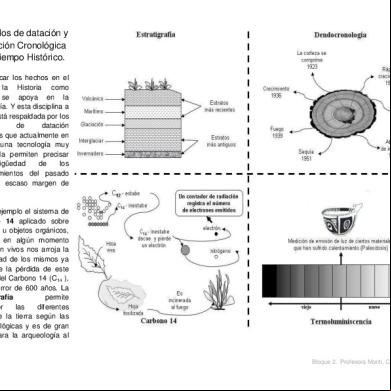Chemical Kinetics Practice Problems 4h2i4w
This document was ed by and they confirmed that they have the permission to share it. If you are author or own the copyright of this book, please report to us by using this report form. Report 3i3n4
Overview 26281t
& View Chemical Kinetics Practice Problems as PDF for free.
More details 6y5l6z
- Words: 357
- Pages: 2
Chemical Kinetics Practice Problems 1. Balance the equation below and determine the rate expression using the given data. Find k with units. N2 + 3H2 --->2 NH3 (all gaseous) [N2] (M) [H2] (M) Initial Rate (M/min) 0.10 0.10 0.0021 0.10 0.20 0.0084 0.20 0.40 0.0672 Rate Law: Rate = k[N2]a[H2]b Find b: (0.0084/0.0021) = (0.20/0.10)b 4 = 2b, so b = 2 Find a: (0.0672/0.0084) = (0.20/0.10)a(0.40/0.20)2 8 = (2a)(4) ; 2 = 2a, so a = 1 Rate Law: Rate = k[N2][H2]2 Find k with units: 0.0021 M/min = k(0.10M)(0.10M)2 k = (0.0021 M/min)/(0.0010 M3) k = 2.1 1/(M2*min)
2. Find the decomposition of NOCl to NO and Cl2 has k = 9.3x10-5 1/M.s at 100 degC and k = 1.0x10-3 1/M.s at 130degC. What is the activation energy of this reaction?
Use the combined Arrhenius equation: ln(k2/k1) = (EA/R)(1/T1 - 1/T2) k1 = 9.3x10-5 1/M.s when T1 = 100degC or 373K k2 = 1.0x10-3 1/M.s when T2 = 130degC or 403K ln(1.0x10-3 /9.3x10-5 ) = (EA/8.3145 J/mol*K)(1/373K - 1/403K) 375= EA*(2.40x10-5 ) EA = 2.375/(2.40x10-5 ) = 99,000 J/mol, or 99 kJ/mol = 1.0x10-3 1/M.s at 130degC. 3. The halogen astatine can only be obtained artificially through bombardment. It has been found to be useful for the treatment of certain types of cancer of the thyroid gland. One form of radioactive astatine is an a particle emitter with a half-life of 7.21 hr. If a sample containing 0.100 mg of astatine is given to a person at 9 a.m. one morning, how much astatine will remain after about 14 hours? Half-lives are constant for first order reactions. ln2 = kthalf thalf = 7.21 hr, so k = ln2/7.21 hr = 0.0961 hr-1 ln(final/initial) = -kt ln(final/0.100 mg) = -(0.0961 hr-1)(14 hr) = -1.35 (final/0.100 mg) = e^(-1.35) = 0.260 final = (0.260)(0.100 mg) = 0.026 mg astatine remaining
4. It took 143. seconds for 50.0% of a substance to decompose. If the initial concentration was 0.060 M and the reaction is first order, what is the value of the rate constant with units? thalf = 143 seconds, so k = ln2/143 s = 0.00485 s-1
2. Find the decomposition of NOCl to NO and Cl2 has k = 9.3x10-5 1/M.s at 100 degC and k = 1.0x10-3 1/M.s at 130degC. What is the activation energy of this reaction?
Use the combined Arrhenius equation: ln(k2/k1) = (EA/R)(1/T1 - 1/T2) k1 = 9.3x10-5 1/M.s when T1 = 100degC or 373K k2 = 1.0x10-3 1/M.s when T2 = 130degC or 403K ln(1.0x10-3 /9.3x10-5 ) = (EA/8.3145 J/mol*K)(1/373K - 1/403K) 375= EA*(2.40x10-5 ) EA = 2.375/(2.40x10-5 ) = 99,000 J/mol, or 99 kJ/mol = 1.0x10-3 1/M.s at 130degC. 3. The halogen astatine can only be obtained artificially through bombardment. It has been found to be useful for the treatment of certain types of cancer of the thyroid gland. One form of radioactive astatine is an a particle emitter with a half-life of 7.21 hr. If a sample containing 0.100 mg of astatine is given to a person at 9 a.m. one morning, how much astatine will remain after about 14 hours? Half-lives are constant for first order reactions. ln2 = kthalf thalf = 7.21 hr, so k = ln2/7.21 hr = 0.0961 hr-1 ln(final/initial) = -kt ln(final/0.100 mg) = -(0.0961 hr-1)(14 hr) = -1.35 (final/0.100 mg) = e^(-1.35) = 0.260 final = (0.260)(0.100 mg) = 0.026 mg astatine remaining
4. It took 143. seconds for 50.0% of a substance to decompose. If the initial concentration was 0.060 M and the reaction is first order, what is the value of the rate constant with units? thalf = 143 seconds, so k = ln2/143 s = 0.00485 s-1










